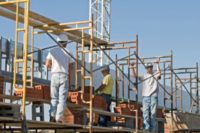Olympic accomplishment: No fatalities in 80+ million hours worked on construction
 The U.K.'s Health and Safety Executive (HSE) has compiled health and safety lessons learned from the agency’s role as a regulator for the massive construction project completed for the 2012 Olympic Games in London.
The U.K.'s Health and Safety Executive (HSE) has compiled health and safety lessons learned from the agency’s role as a regulator for the massive construction project completed for the 2012 Olympic Games in London.
In collaboration with the Olympic Delivery Authority (ODA), HSE performed a series of research projects and case studies during the construction for the Games. Topics include leadership and worker involvement, safety culture and supply chain management. This new information is posted on HSE’s website.
The "big build" for the London 2012 Olympic Games—the construction of the venues, Olympic Village and the rest of the infrastructure—was completed "on time, within budget and with an exemplary health and safety record" in July 2011.
HSE reports that health and safety was ODA’s top priority during construction, and that the resulting numbers related to workplace safety reflect their commitment.
Forty-six thousand workers helped build the Olympic Park, working more than 80 million man-hours, according to HSE. There were no work-related fatalities during construction, and the accident frequency rate was 0.16 (well below average for the U.K.'s construction industry).
A seven-minute video, "Raising the Bar for Health," summarizes occupational health management during the construction of Olympic Park and Olympic Village. Watch the video on YouTube.
"[The main construction project for London 2012] has demonstrated that building projects on time and within budget does not mean compromising on the health and safety of workers," HSE's website states. Learn more about HSE's role during preparation for London 2012.
Looking for a reprint of this article?
From high-res PDFs to custom plaques, order your copy today!







